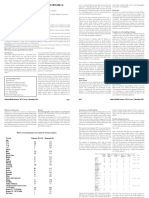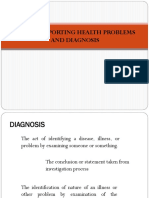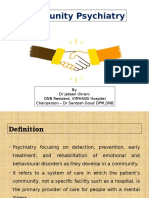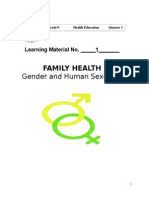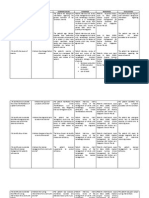Professional Documents
Culture Documents
Model of Dental and Oral Health Care Services On Decreasing Debris Index Scores in The Implementation of Oral Hygiene in Elderly With Dementia
Original Title
Copyright
Available Formats
Share this document
Did you find this document useful?
Is this content inappropriate?
Report this DocumentCopyright:
Available Formats
Model of Dental and Oral Health Care Services On Decreasing Debris Index Scores in The Implementation of Oral Hygiene in Elderly With Dementia
Copyright:
Available Formats
Volume 6, Issue 11, November – 2021 International Journal of Innovative Science and Research Technology
ISSN No:-2456-2165
Model of Dental and Oral Health Care Services on
Decreasing Debris Index Scores in the
Implementation of Oral Hygiene
in Elderly with Dementia
Nuraisya, Rasipin, Endaharyati Eko ningtyas, Diyah Fatmasari, Bedjo Santoso
Poltekkes Kemenkes Semarang,Dental Therapist and Hygienist
Tirto Agung Rd, Semarang Central Java, 50628, Indonesia
Abstract:-Background: Oral hygiene is still a major Nations Fund for Population Activities (UNFPA), there are
problem for the elderly. Riskesdas in 2018 stated that currently around 737 million elderly people in the word. [3]
dental problems in the 55-64 age group increased by 48.5%
and those aged 65 and over by 38.6%. The government's Dementia (senile) is a cognitive decline that is so severe
efforts to realize dental and oral health services are that it interferes with activities of daily living and social
regulated in Kepmenkes No. 58 of 2012 and its activities experienced by a person. [4] Dementia in the elderly
implementation is regulated in Kepmenkes No. 284 of 2006 is a condition of general and progressive cognitive impairment
but the implementation of dental and oral health care for related to the physical health of the elderly. Elderly people
the elderly with dementia has not yet been specifically aged over 60 years are often found with dementia problems
implemented, so an innovative model of developing oral which until now it is estimated that more than 30 million
health care is needed that is designed according to the people worldwide suffer from dementia with various causes.
needs of the elderly with dementia in performing oral [5]
hygiene. independently. Research Objectives: a model of
dental and oral health care for the elderly with dementia With age, aging is unavoidable and every individual will
that is feasible and effective in reducing the debris index experience changes both physically and mentally. In addition,
score in the implementation of oral hygiene for the elderly the elderly experience natural processes and changes in the
function of body tissues, including changes in oral tissues,
with dementia. Methods: Research and development
such as dry mouth, pale mucosa, thinning of the mucosa,
(R&D) with a quasi-experimental method of pre-test and
post-test with control group design. The research subjects attrition and tooth loss. [6],[7]
were divided into 2 groups, namely 16 intervention groups Oral hygiene is still the main problem for the elderly.
and 16 control groups. The research instrument used a Poor oral hygiene in the elderly will affect the masticatory
questionnaire and an observation sheet, with DI as the function, because the chewing function will decrease, which
variable. The statistical test used the Intraclass correlation will affect overall health and nutritional status, which will
coefficient for expert validation, and the dependent cause the elderly to avoid certain foods, especially foods that
variable used the Man Whitney, Wilcosxon, Paired and are difficult to chew and cause changes in eating patterns. [8]
Independent sample test. Result : Dental and oral health Dental and oral hygiene is one of the main factors that trigger
care for elderly with dementia is relevant in lowering the various oral diseases, especially dental caries, periodontal
Debris Index score (p=<0.001) compared to the control disease and various infectious diseases and even tooth loss.
group. Conclusion: The development of a model of dental dental disease is the elderly.[11] This situation shows that
and oral health care for the elderly with dementia is Indonesia's dental and oral diseases are still high, and the needs
feasible and its application is effective for the of the Indonesian people for dental treatment (dental treatment
implementation of oral hygiene in the elderly compared to needs) are still high.[12]
the control group.
Minister of Health Regulation No. 58 of 2012 concerning
Keywords:- Dental and oral health care, Elderly dementia. the implementation of dental nurses, the main task of dental
I. INTRODUCTION nurses in carrying out dental and oral health care services for
individuals, groups, and communities in health care
Elderly is an age group in humans who have entered the facilities.Permenkes No. 58 of 2012, dental and oral health
final stages of the phase of life. In this group categorized as care is a systematic approach process in the fields of
elderly, an aging process will occur which is characterized by promotive, preventive, and simple curative.[13] Dental and
changes in the physical and mental health of the elderly.[1] In oral health care services are planned dental and oral health
line with the increasing age of a person and the process of services, which can be carried out for certain community
decline followed by the emergence of physiological disorders, groups within a certain period of time, and are carried out
decreased function, cognitive disorders, affective and continuously in the simple promotive, preventive, and curative
psychosocial disorders. [2] Based on data from the United fields provided to individuals, groups, and communities. [14].
IJISRT21NOV439 www.ijisrt.com 749
Volume 6, Issue 11, November – 2021 International Journal of Innovative Science and Research Technology
ISSN No:-2456-2165
II. METHODOLOGY Score Mean p-Value*
The design of this study was a quasi-experimental Pretest
and Post-test Design (Non Equvalent Control Group). Expert
Respondents consisted of 32 elderly people with dementia. behavior 92
The minimum sample size required is 32 people. The sample dental and oral health care 98 96 0.003
was divided into two, namely 16 people for the intervention gariatrics 98
and control groups. The elderly with dementia who became the Table 1. Expert Validation
object of the study were the elderly in the working area of the Interclass correlation coefficient
Padang Sari Public Health Center and the Pudak Payung
Public Health Center, Semarang City. Based on the results of the assessment of 3 expert
validators, it is known that the distribution of frequency data
The instrument for implementing the Askepgilut model for behavioral experts is 92%, dental and oral health care
in the elderly with dementia uses an assessment sheet using a professionals are 98%, and gariatry experts are 98%. The
questionnaire and an observation sheet, with the variable average value of eligibility is 96 with a very decent category.
Debris Index. while the feasibility of the model was measured The results of expert validation show that the p-value = 0.003
using the askepgilut instrument which was designed based on means that the dental and oral health care model for the elderly
the characteristics of the elderly. is relevant as a method of dental and oral health education for
the elderly with dementia.
The research data uses an interval scale, statistical tests
use the intraclass correlation coefficient to determine the D. Model Test
feasibility of the module. Meanwhile, the normality test used Variabel P-volue
the Shapiro Wilk test because the number of respondents was Intervensi Kontrol
less than 50. The effectiveness test on normal data for the (n=16) (n=16)
paired group used the dependent sample test and for the DI Pre-Test 0,628 0,201
unpaired group, the independent sample test was used. DI Pos-Test 0,277 0,100
III. RESULTSAND DISCUSSION Table 2. Normality Test Data Debris Index Elderly
*Shapiro-Wilk
A. Data Collection
The results of information collection were carried out The results of the normality test showed that the Debris
through interviews and systematic reviews which concluded Index intervention group had a P-Value value > 0.05 so it
that oral hygiene is still the most important problem for the could be concluded that the data were normally distributed, so
elderly. awareness of the elderly regarding oral hygiene is still the parametric test was continued.
low. This is because the elderly are indifferent to taking care
of themselves related to dental and oral health, so the elderly Paired t-test*
need assistance with the participation of the family to maintain
dental and oral health in the elderly. There is no dental health kelompok mean±SD mean±SD P-value
maintenance program for the elderly, specifically for teeth. pre-test pos-test
intervensi 2,56±0,512 1,63±0,500 0,000
B. Design and Build
The collection of information produces data that is used to kontrol 2,94±0,250 2,50±0,516 0,004
design a model of dental and oral health care for the elderly
with dementia that is tailored to the needs of the elderly with Table 3. I Paired t-Test Results
dementia. The results of collecting information revealed that *Wilcoxon
there was no dental and oral health care for the elderly with
dementia so that oral hygiene in the elderly was still poor. So The results of the paired data effectiveness test for
the researchers made dental and oral health care for the elderly elderly with dementia showed that the P-value of the
that were adapted to methods that were suitable for the elderly. intervention group was 0.000 (p<0.05), meaning that the
development of a dental andoral health care model was
C. Expert Validation effective in reducing DI in the implementation of oral hygiene
There are 3 validarors, namely behavioral experts, dental in the elderly. The p-value of the DI in the control group was
andoral health care experts, gariatricexperts. Validation was 0.004 (p<0.05), meaning that the oral health care model used
carriedout to obtain data that was used as a basis for testing the in the control group was effective in reducing DI in the elderly
feasibility of the model of dental and oral health care for the with dementia in the implementation of oral hygiene.
elderly with dementia
IJISRT21NOV439 www.ijisrt.com 750
Volume 6, Issue 11, November – 2021 International Journal of Innovative Science and Research Technology
ISSN No:-2456-2165
Independent t-Test** journal on dental care and characteristics of the elderly
[6],[13],[16].
kelompok mean±SD mean±SD
pre-test pos-test F. Discussion
For the implementation of oral hygiene in the elderly in an
intervensi 2,56±0,512 1,63±0,500 effort to reduce the debris index score in the elderly with
dementia, special efforts are needed through the
kontrol 2,69±0,479 2,38±0,619
implementation of dental and oral health care for the elderly in
P-value 0,481 0,001 its implementation and assistance by the family, based on the
opinion of Desi (2015). receive special attention because it
Table 4. Independent t-Test Results affects general health. Good knowledge of oral hygiene is very
**Independent Sample Test important to prevent dental and oral diseases. Maintaining oral
hygiene is one way to maintain the condition of the elderly
The results of the test of the effectiveness of the unpaired body.[17]
data DI the pre-test data between the intervention group and The increasing number of the elderly population will
the control group were not significantly different, it could be cause problems, one of which is self-care for the elderly who
seen that the p-value was 0.481 (p>0.05) while the post-test are reduced about dental and oral hygiene. Poor oral hygiene
data for the intervention and control groups were significantly can cause health services to increase, besides that there is a
different, it was seen that the p-values were significantly physical decline such as difficulties in communication and
different. -value is 0.001 (p<0.05) meaning that the socializing experienced by the elderly.[18],[19].
development of a model of oral health care for the elderly with
dementia is more effective in improving attitudes in the Any type of serious dental health problems in the mouth
implementation of oral hygiene compared to the care used in will cause oral infections that cause respiratory problems in
the control group. This is evidenced by the decrease in the the elderly. The elderly are at risk for oral health problems due
average value after being treated in the intervention group to lack of knowledge about oral hygiene, inability to perform
better than the control group, namely the intervention group to oral care, or changes in the integrity of the teeth and mucosa
1.63 while the control group to 2.38. due to disease.[20]
Unpaired Data Test Value Change (∆)** IV. CONCLUSION AND RECOMMENDATIONS
Mean±SD P-value Based on the results of the study, it can be concluded that
Pre-Post Tes the dental and oral health care model is feasible and its
application is effective in the implementation of oral hygiene
intervensi 2,25±1,732 0,000 in reducing the scoe debris index in the elderly with dementia.
kontrol 0,31±0,479
The suggestion from the author is for further researchers,
Table 5. Unpaired Data Test Value Change (∆)** it is hoped that further research can be carried out by
categorizing the age of the elderly towards this model of dental
The results of the unpaired data test, the pre-post delta
and oral health care, as well as being able to conduct research
(∆) values were significantly different, it was seen that the p-
with different methods and develop research variables.
value was 0.000 (p<0.05), meaning that the development of a
model of oral health care for the elderly with dementia was
REFERENCES
effective in reducing DI scores in the implementation of oral
hygiene compared to with the care used in the control group. [1.] Nauli Fa, Ismalinda W, Dewi Ap. Hubungan Keberadaan
This is evidenced by the increase in the average value after Pasangan Hidup Dengan Harga Diri Pada Lansia 1 1,3. J
being treated in the intervention group better than the control Kepearawan Jiwa 2014; 2: 24–30.
group, namely the intervention group to 2.25 while the control [2.] Suwarni S, Setiawan S, Syatibi Mm. Hubungan Usia
group to 0.31. Demensia Dan Kemampuan Fungsional Pada Lansia. J
Keterapian Fis 2017; 2: 34–41.
E. Model Result [3.] Afriani T, Yurnalis, Arlina F, Putra De. Warta
The product is a model of dental and oral health care for Pengabdian Andalas. War Pengamdian Andalas 2019;
the elderly. This model was prepared for dental health workers 26: 16–22.
or dental and oral therapists about the basic concepts of [4.] Alvin Abdillah, J, Luluk Fauziyah.
implementing a model of dental and oral health care for the HubunganTugasKesehatanKeluargaDengan Tingkat
elderly with dementia in relation to increasing the participation DemensiaPadaLansiaJurnal Kesehatan Medika Udayana
of dental and oral health workers in the implementation of Vol.06 No.02 Oktober 2020
promotive and preventive efforts in the field of dental health, [5.] Siegel Ba. 2014 Cassen Lecture: What Have We Learned
especially those who associated with increasing the ability of From The National Oncologic Pet Registry? J Nucl Med
the elderly in increasing efforts to reduce the debris index 2014; 55: 9n-15n.
score in the elderly with dementia. This model was developed [6.] Kementrian Kesehatan Ri. Analisis Lansia Di Indonesia.
from the dental and oral health care model listed in the Pus Data Dan Inf Kementeri Kesehat Ri 2017.
Minister of Health No. 284 of 2006 with reference to the
IJISRT21NOV439 www.ijisrt.com 751
Volume 6, Issue 11, November – 2021 International Journal of Innovative Science and Research Technology
ISSN No:-2456-2165
[7.] Maryati, Purnamasari Erw. Life Review Therapy On
Depression Levels In Elderly Socially Guided Citizens
In Budi Mulia Pstw Budi Mulia 3 South Jakarta. J Ilm
2020; Vol. 15, N: 8.
[8.] Abdat M, Jernita T. Oral Health Knowledge And
Attitude, Oral Health Status In Elderly And Its Impact
On General Well-Being. Dentika Dent J 2018; 21: 21–
28.
[9.] Pindobilowo P. Pengaruh Oral Hygiene Terhadap
Malnutrisi Pada Lansia. J Ilm Dan Teknol Kedokt Gigi
2018; 14: 1.
[10.] Mulyawati A, Romdlon Ma. Optimalisasi Potensi Kader
Posyandu Dalam Upaya Peningkatan Kesehatan Gigi
Dan Mulut Lansia Di Dusun Semaya, Kecamatan
Karanglewas,Kabupaten Banyumas. J Pengemb Sumber
Daya Perdesaan 2018; : 77–87.
[11.] Ermawati T. Profil Kebersihan Dan Perilaku Menjaga
Kesehatan Gigi Dan Mulut Pada Lansia Di Desa Darsono
Kabupaten Jember. Ikesma 2016; 12: 77–83.
[12.] Rosidah Ne, Nurbayani S, Barus A, Sofian R, Purnama
T, Bekasi P Et Al. Di Poliklinik Pertamedika Bekasi
Periode Dental And Mouth Care Needs In Elderly
Patients In Pertamedika. 2020; 1: 1–5.
[13.] Kementrian Kesehatan Ri. Hasil Riset Kesehatan Dasar
(Riskesdas). 2018.
[14.] Peraturan Menteri Kesehatan. Peraturan Menteri
Kesehatan Republik Indonesia Nomor 58 Tahun 2012.
2013.
[15.] Erni Gultom Rd. Bahan Ajar Kesehatan Gigi Konsep
Dasar Pelayanan Kesehatan Gigi Dan Mulut I. 2017, P 3.
[16.] Sari D, Sandra, Arina Ymd, Ermawati T. Hubungan
Pengetahuan Kesehatan Gigi Mulut Dengan Status
Kebersihan Rongga Mulut Pada Lansia. J Ikesmas 2015;
11: 44–51.
[17.] Gao Ss, Chen Kj, Duangthip D, Lo Ecm, Chu Ch. The
Oral Health Status Of Chinese Elderly People With And
Without Dementia: A Cross-Sectional Study. Int J
Environ Res Public Health 2020; 17: 3–10.
[18.] Wong Fmf. First Data In The Process Of Validating A
Tool To Evaluate Knowledge, Attitude And Practice Of
Healthcare Providers In Oral Care Of Institutionalized
Elderly Residents: Content Validity, Reliability And
Pilot Study. Int J Environ Res Public Health 2021; 18.
Doi:10.3390/Ijerph18084145.
[19.] Kesehatan Fi, Surakarta Um. Irawati J210.080.032.
Pengaruh Pendidik Kesehat Terhadap Pengetah Oral
Hyg Pada Lanjut Usia Di Wil Kerja Puskesmas
Karangmalang Kabupaten Sragen 2012; : 14.
[20.] Riskesdas K. Hasil Utama Riset Kesehata Dasar
(Riskesdas). J Phys A Math Theor 2018; 44: 1–200.
IJISRT21NOV439 www.ijisrt.com 752
You might also like
- Diabetic Retinopathy Stage Detection Using CNN and Inception V3Document9 pagesDiabetic Retinopathy Stage Detection Using CNN and Inception V3International Journal of Innovative Science and Research TechnologyNo ratings yet
- Exploring the Molecular Docking Interactions between the Polyherbal Formulation Ibadhychooranam and Human Aldose Reductase Enzyme as a Novel Approach for Investigating its Potential Efficacy in Management of CataractDocument7 pagesExploring the Molecular Docking Interactions between the Polyherbal Formulation Ibadhychooranam and Human Aldose Reductase Enzyme as a Novel Approach for Investigating its Potential Efficacy in Management of CataractInternational Journal of Innovative Science and Research TechnologyNo ratings yet
- Investigating Factors Influencing Employee Absenteeism: A Case Study of Secondary Schools in MuscatDocument16 pagesInvestigating Factors Influencing Employee Absenteeism: A Case Study of Secondary Schools in MuscatInternational Journal of Innovative Science and Research TechnologyNo ratings yet
- An Analysis on Mental Health Issues among IndividualsDocument6 pagesAn Analysis on Mental Health Issues among IndividualsInternational Journal of Innovative Science and Research TechnologyNo ratings yet
- Harnessing Open Innovation for Translating Global Languages into Indian LanuagesDocument7 pagesHarnessing Open Innovation for Translating Global Languages into Indian LanuagesInternational Journal of Innovative Science and Research TechnologyNo ratings yet
- The Utilization of Date Palm (Phoenix dactylifera) Leaf Fiber as a Main Component in Making an Improvised Water FilterDocument11 pagesThe Utilization of Date Palm (Phoenix dactylifera) Leaf Fiber as a Main Component in Making an Improvised Water FilterInternational Journal of Innovative Science and Research TechnologyNo ratings yet
- Advancing Healthcare Predictions: Harnessing Machine Learning for Accurate Health Index PrognosisDocument8 pagesAdvancing Healthcare Predictions: Harnessing Machine Learning for Accurate Health Index PrognosisInternational Journal of Innovative Science and Research TechnologyNo ratings yet
- The Relationship between Teacher Reflective Practice and Students Engagement in the Public Elementary SchoolDocument31 pagesThe Relationship between Teacher Reflective Practice and Students Engagement in the Public Elementary SchoolInternational Journal of Innovative Science and Research TechnologyNo ratings yet
- The Making of Object Recognition Eyeglasses for the Visually Impaired using Image AIDocument6 pagesThe Making of Object Recognition Eyeglasses for the Visually Impaired using Image AIInternational Journal of Innovative Science and Research TechnologyNo ratings yet
- Design, Development and Evaluation of Methi-Shikakai Herbal ShampooDocument8 pagesDesign, Development and Evaluation of Methi-Shikakai Herbal ShampooInternational Journal of Innovative Science and Research Technology100% (3)
- Dense Wavelength Division Multiplexing (DWDM) in IT Networks: A Leap Beyond Synchronous Digital Hierarchy (SDH)Document2 pagesDense Wavelength Division Multiplexing (DWDM) in IT Networks: A Leap Beyond Synchronous Digital Hierarchy (SDH)International Journal of Innovative Science and Research TechnologyNo ratings yet
- Terracing as an Old-Style Scheme of Soil Water Preservation in Djingliya-Mandara Mountains- CameroonDocument14 pagesTerracing as an Old-Style Scheme of Soil Water Preservation in Djingliya-Mandara Mountains- CameroonInternational Journal of Innovative Science and Research TechnologyNo ratings yet
- The Impact of Digital Marketing Dimensions on Customer SatisfactionDocument6 pagesThe Impact of Digital Marketing Dimensions on Customer SatisfactionInternational Journal of Innovative Science and Research TechnologyNo ratings yet
- Formulation and Evaluation of Poly Herbal Body ScrubDocument6 pagesFormulation and Evaluation of Poly Herbal Body ScrubInternational Journal of Innovative Science and Research TechnologyNo ratings yet
- Electro-Optics Properties of Intact Cocoa Beans based on Near Infrared TechnologyDocument7 pagesElectro-Optics Properties of Intact Cocoa Beans based on Near Infrared TechnologyInternational Journal of Innovative Science and Research TechnologyNo ratings yet
- Comparatively Design and Analyze Elevated Rectangular Water Reservoir with and without Bracing for Different Stagging HeightDocument4 pagesComparatively Design and Analyze Elevated Rectangular Water Reservoir with and without Bracing for Different Stagging HeightInternational Journal of Innovative Science and Research TechnologyNo ratings yet
- Auto Encoder Driven Hybrid Pipelines for Image Deblurring using NAFNETDocument6 pagesAuto Encoder Driven Hybrid Pipelines for Image Deblurring using NAFNETInternational Journal of Innovative Science and Research TechnologyNo ratings yet
- Review of Biomechanics in Footwear Design and Development: An Exploration of Key Concepts and InnovationsDocument5 pagesReview of Biomechanics in Footwear Design and Development: An Exploration of Key Concepts and InnovationsInternational Journal of Innovative Science and Research TechnologyNo ratings yet
- A Survey of the Plastic Waste used in Paving BlocksDocument4 pagesA Survey of the Plastic Waste used in Paving BlocksInternational Journal of Innovative Science and Research TechnologyNo ratings yet
- Hepatic Portovenous Gas in a Young MaleDocument2 pagesHepatic Portovenous Gas in a Young MaleInternational Journal of Innovative Science and Research TechnologyNo ratings yet
- Explorning the Role of Machine Learning in Enhancing Cloud SecurityDocument5 pagesExplorning the Role of Machine Learning in Enhancing Cloud SecurityInternational Journal of Innovative Science and Research TechnologyNo ratings yet
- Cyberbullying: Legal and Ethical Implications, Challenges and Opportunities for Policy DevelopmentDocument7 pagesCyberbullying: Legal and Ethical Implications, Challenges and Opportunities for Policy DevelopmentInternational Journal of Innovative Science and Research TechnologyNo ratings yet
- Automatic Power Factor ControllerDocument4 pagesAutomatic Power Factor ControllerInternational Journal of Innovative Science and Research TechnologyNo ratings yet
- Navigating Digitalization: AHP Insights for SMEs' Strategic TransformationDocument11 pagesNavigating Digitalization: AHP Insights for SMEs' Strategic TransformationInternational Journal of Innovative Science and Research TechnologyNo ratings yet
- Studying the Situation and Proposing Some Basic Solutions to Improve Psychological Harmony Between Managerial Staff and Students of Medical Universities in Hanoi AreaDocument5 pagesStudying the Situation and Proposing Some Basic Solutions to Improve Psychological Harmony Between Managerial Staff and Students of Medical Universities in Hanoi AreaInternational Journal of Innovative Science and Research TechnologyNo ratings yet
- Mobile Distractions among Adolescents: Impact on Learning in the Aftermath of COVID-19 in IndiaDocument2 pagesMobile Distractions among Adolescents: Impact on Learning in the Aftermath of COVID-19 in IndiaInternational Journal of Innovative Science and Research TechnologyNo ratings yet
- A Review: Pink Eye Outbreak in IndiaDocument3 pagesA Review: Pink Eye Outbreak in IndiaInternational Journal of Innovative Science and Research TechnologyNo ratings yet
- Drug Dosage Control System Using Reinforcement LearningDocument8 pagesDrug Dosage Control System Using Reinforcement LearningInternational Journal of Innovative Science and Research TechnologyNo ratings yet
- The Effect of Time Variables as Predictors of Senior Secondary School Students' Mathematical Performance Department of Mathematics Education Freetown PolytechnicDocument7 pagesThe Effect of Time Variables as Predictors of Senior Secondary School Students' Mathematical Performance Department of Mathematics Education Freetown PolytechnicInternational Journal of Innovative Science and Research TechnologyNo ratings yet
- Formation of New Technology in Automated Highway System in Peripheral HighwayDocument6 pagesFormation of New Technology in Automated Highway System in Peripheral HighwayInternational Journal of Innovative Science and Research TechnologyNo ratings yet
- Never Split the Difference: Negotiating As If Your Life Depended On ItFrom EverandNever Split the Difference: Negotiating As If Your Life Depended On ItRating: 4.5 out of 5 stars4.5/5 (838)
- Shoe Dog: A Memoir by the Creator of NikeFrom EverandShoe Dog: A Memoir by the Creator of NikeRating: 4.5 out of 5 stars4.5/5 (537)
- The Subtle Art of Not Giving a F*ck: A Counterintuitive Approach to Living a Good LifeFrom EverandThe Subtle Art of Not Giving a F*ck: A Counterintuitive Approach to Living a Good LifeRating: 4 out of 5 stars4/5 (5794)
- The Yellow House: A Memoir (2019 National Book Award Winner)From EverandThe Yellow House: A Memoir (2019 National Book Award Winner)Rating: 4 out of 5 stars4/5 (98)
- Hidden Figures: The American Dream and the Untold Story of the Black Women Mathematicians Who Helped Win the Space RaceFrom EverandHidden Figures: The American Dream and the Untold Story of the Black Women Mathematicians Who Helped Win the Space RaceRating: 4 out of 5 stars4/5 (894)
- The Little Book of Hygge: Danish Secrets to Happy LivingFrom EverandThe Little Book of Hygge: Danish Secrets to Happy LivingRating: 3.5 out of 5 stars3.5/5 (399)
- Elon Musk: Tesla, SpaceX, and the Quest for a Fantastic FutureFrom EverandElon Musk: Tesla, SpaceX, and the Quest for a Fantastic FutureRating: 4.5 out of 5 stars4.5/5 (474)
- A Heartbreaking Work Of Staggering Genius: A Memoir Based on a True StoryFrom EverandA Heartbreaking Work Of Staggering Genius: A Memoir Based on a True StoryRating: 3.5 out of 5 stars3.5/5 (231)
- Grit: The Power of Passion and PerseveranceFrom EverandGrit: The Power of Passion and PerseveranceRating: 4 out of 5 stars4/5 (587)
- Devil in the Grove: Thurgood Marshall, the Groveland Boys, and the Dawn of a New AmericaFrom EverandDevil in the Grove: Thurgood Marshall, the Groveland Boys, and the Dawn of a New AmericaRating: 4.5 out of 5 stars4.5/5 (266)
- On Fire: The (Burning) Case for a Green New DealFrom EverandOn Fire: The (Burning) Case for a Green New DealRating: 4 out of 5 stars4/5 (73)
- The Emperor of All Maladies: A Biography of CancerFrom EverandThe Emperor of All Maladies: A Biography of CancerRating: 4.5 out of 5 stars4.5/5 (271)
- The Hard Thing About Hard Things: Building a Business When There Are No Easy AnswersFrom EverandThe Hard Thing About Hard Things: Building a Business When There Are No Easy AnswersRating: 4.5 out of 5 stars4.5/5 (344)
- The Unwinding: An Inner History of the New AmericaFrom EverandThe Unwinding: An Inner History of the New AmericaRating: 4 out of 5 stars4/5 (45)
- Team of Rivals: The Political Genius of Abraham LincolnFrom EverandTeam of Rivals: The Political Genius of Abraham LincolnRating: 4.5 out of 5 stars4.5/5 (234)
- The World Is Flat 3.0: A Brief History of the Twenty-first CenturyFrom EverandThe World Is Flat 3.0: A Brief History of the Twenty-first CenturyRating: 3.5 out of 5 stars3.5/5 (2219)
- The Gifts of Imperfection: Let Go of Who You Think You're Supposed to Be and Embrace Who You AreFrom EverandThe Gifts of Imperfection: Let Go of Who You Think You're Supposed to Be and Embrace Who You AreRating: 4 out of 5 stars4/5 (1090)
- The Sympathizer: A Novel (Pulitzer Prize for Fiction)From EverandThe Sympathizer: A Novel (Pulitzer Prize for Fiction)Rating: 4.5 out of 5 stars4.5/5 (119)
- Her Body and Other Parties: StoriesFrom EverandHer Body and Other Parties: StoriesRating: 4 out of 5 stars4/5 (821)
- Numen Program InformationDocument7 pagesNumen Program InformationysjaitawatNo ratings yet
- Sri Acu Care Clinic - DR Kalyani's Acupuncture Treatment in Tirupati - Speciality Pain Care IndiaDocument7 pagesSri Acu Care Clinic - DR Kalyani's Acupuncture Treatment in Tirupati - Speciality Pain Care IndiaSssbi TeamNo ratings yet
- What Causes Depression - Google SearchDocument1 pageWhat Causes Depression - Google SearchLesedi MokoenaNo ratings yet
- Prioritizing Community Health Problems / Community DiagnosisDocument4 pagesPrioritizing Community Health Problems / Community DiagnosisCA SavageNo ratings yet
- Mha 101Document4 pagesMha 101NIHUGBH KOLKATANo ratings yet
- Health seeking challenges in rural UgandaDocument5 pagesHealth seeking challenges in rural UgandaBhong Moreno SolanoNo ratings yet
- 7 Case Definitions of Infectious Disease in MalaysiaDocument110 pages7 Case Definitions of Infectious Disease in MalaysiaICNo ratings yet
- Case Report Perdarahan CerebellumDocument26 pagesCase Report Perdarahan CerebellumnoirNo ratings yet
- ATS Guidelines for Managing Community-Acquired PneumoniaDocument25 pagesATS Guidelines for Managing Community-Acquired PneumoniaMeme BuletNo ratings yet
- Competency Based EducationDocument33 pagesCompetency Based EducationAncy Varkey100% (1)
- Supreme Court Judgement On Pension To Ex. Armyman Retired On Health GroundsDocument22 pagesSupreme Court Judgement On Pension To Ex. Armyman Retired On Health GroundsLatest Laws TeamNo ratings yet
- CBT for Somatoform Disorders Reduces Healthcare Costs by Over 60Document12 pagesCBT for Somatoform Disorders Reduces Healthcare Costs by Over 60Shinta Dian YustianaNo ratings yet
- CLS105 Week 4 Lecture 1 2019Document22 pagesCLS105 Week 4 Lecture 1 2019sopheeyuhNo ratings yet
- Gundao Bernard Jr. Solicito Definitely A Low-TDocument3 pagesGundao Bernard Jr. Solicito Definitely A Low-TBernard, Jr. GundaoNo ratings yet
- (Asking-Reporting Health Problem and Diagnosing)Document10 pages(Asking-Reporting Health Problem and Diagnosing)nilanNo ratings yet
- A History of Population Control MethodsDocument16 pagesA History of Population Control Methodsfubuhead100% (1)
- Andrew TannahillDocument2 pagesAndrew TannahillbhushanbappiNo ratings yet
- Community Psychiatry - DR Jateen - 3-7-15Document70 pagesCommunity Psychiatry - DR Jateen - 3-7-15Jateen UkraniNo ratings yet
- Wini JR - Treatment of Suspected Sepsis and Septic Shock in Children With Chronic Disease Seen in The Pediatric Emergency DepartmDocument6 pagesWini JR - Treatment of Suspected Sepsis and Septic Shock in Children With Chronic Disease Seen in The Pediatric Emergency DepartmwiniNo ratings yet
- Client Intake FormDocument2 pagesClient Intake FormPeter Sosa100% (1)
- CH 2 Lecture NotesDocument56 pagesCH 2 Lecture Notesapi-375358341No ratings yet
- The Kessler Psychological Distress Scale (K10)Document2 pagesThe Kessler Psychological Distress Scale (K10)octavianNo ratings yet
- College Admission Essay ExampleDocument7 pagesCollege Admission Essay Exampleafibavcbdyeqsx100% (2)
- Epidemiology of Inectious DiseasesDocument23 pagesEpidemiology of Inectious DiseasesAshish ShresthaNo ratings yet
- Grade 8-Q1-LMDocument84 pagesGrade 8-Q1-LMnelbert_nleNo ratings yet
- MAPEH 7 Q4 Week 8Document8 pagesMAPEH 7 Q4 Week 8Maricris ArsibalNo ratings yet
- Incidence of Diarrhoea and Predisposing Factors Among Under Five Children in Nigeria Critical Review JOCCR S8 1048Document11 pagesIncidence of Diarrhoea and Predisposing Factors Among Under Five Children in Nigeria Critical Review JOCCR S8 1048LAWSON IYENE-EMINo ratings yet
- MLC Personal Protection PortfolioDocument112 pagesMLC Personal Protection PortfolioLife Insurance Australia100% (1)
- Demographic Profile GenogramDocument3 pagesDemographic Profile GenogramErika Danalle ArceoNo ratings yet
- Anemia Learning ObjectivesDocument3 pagesAnemia Learning ObjectivesJoanne GomezNo ratings yet












































































